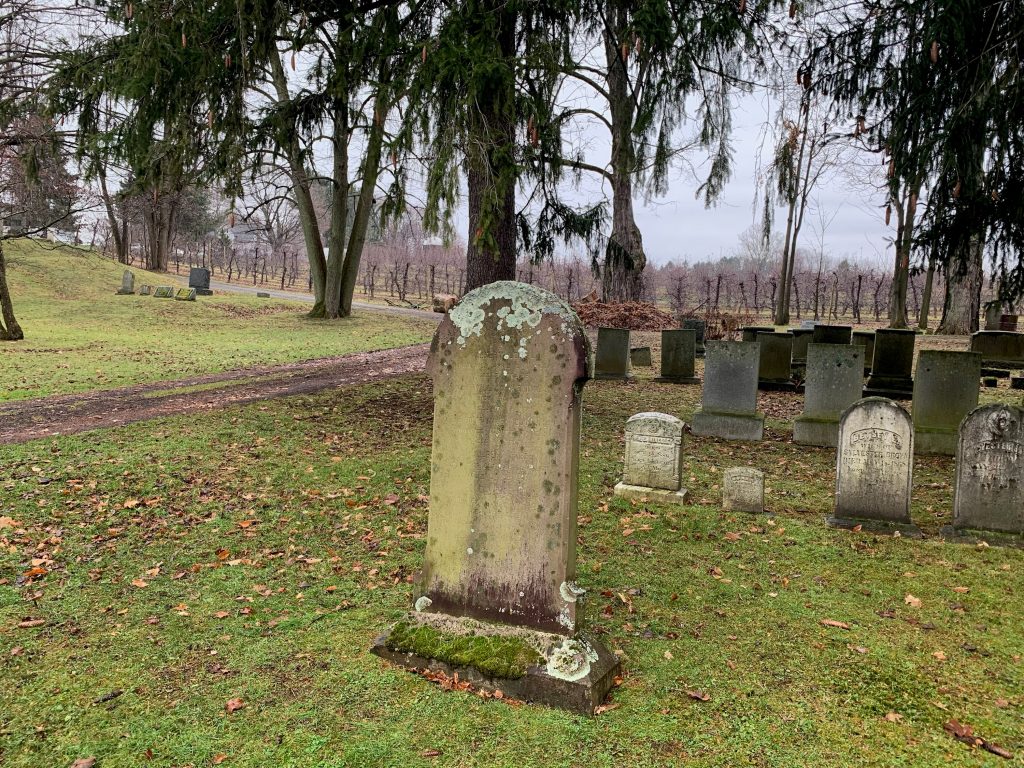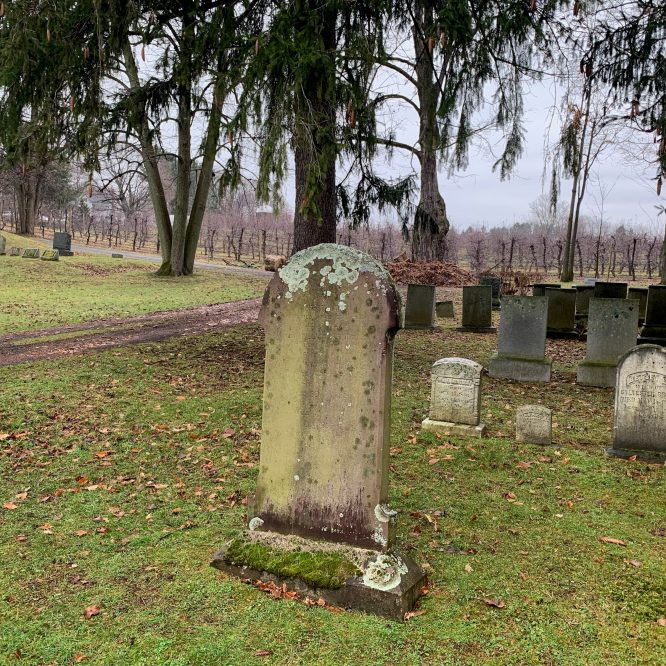Vol. 6, No. 4
The use of Medina sandstone to craft headstones was rather limited in the nineteenth century. County Historian C. W. Lattin has speculated that the common use of the stone for curbing and paving blocks made the durable material undesirable for such a noble purpose. In Orleans County, sandstone within cemeteries is often observed in hitching posts, carriage steps, and monument foundations. However, the presence of sandstone monuments became common among immigrant quarry laborers. The stone represented the livelihood of the deceased individual. It was readily accessible, often affordable, and on other occasions, a quarry owner might gift a slab of stone for use in the case of an untimely death. This particular monument at Mt. Albion Cemetery represents a rather unusual occurrence. Five English quarrymen are buried on this lot with this large, beautiful sandstone monument erected to their memory by friends and fellow quarry laborers.
On May 3, 1883, the Medina Tribune recorded the death of a man named “Fred” Long who died at Pt. Breeze. At the age of twenty-one, Long was fishing with friends in a boat between the piers on the Oak Orchard River when the boat suddenly filled with water. The vessel capsized and Long’s two fishing companions were rescued with ropes from bystanders. Unfortunately, Long drowned as a result of the accident. Albert Long was born at Bradford, Yorkshire, England and appears in the 1881 England Census, employed as a stone dresser and living with his grandparents, John and Hannah Smith. The whereabouts of his parents are unknown, but it appears as though he was sent to live with his maternal grandparents at an early age. Long appears on the April 13, 1883 manifest of the R.M.S. City of Richmond, traveling in steerage quarters and listing his employment as a mason. This information is confirmed by his notice of death in the April 27, 1883 edition of the Jamestown Evening Journal, which notes that he arrived in the U.S. just two weeks prior. It is believed that a son, John Albert Long, was born to his widow in England in August of 1883.
The second of the men listed is William Kendall, born in 1824 at Baildon, Yorkshire, England. He appears on the May 9, 1883 manifest of the S.S. Sardinia as a mason traveling from England and he appears in the 1881 England Census in Yorkshire, married to Mary Halliday. According to the Orleans Republican, Kendall was suffering from a long-term illness and his son Thomas, already living in Orleans County, coaxed his father to the U.S. in the hopes of improving his condition. On July 5, 1883, Kendall succumbed to his illness. His funeral was held in Christ Church and a procession of over 100 Englishmen followed the casket to the cemetery. Kendall left his widow in England, just eight weeks after his arrival in the U.S.
The third name listed on the stone is that of Bottomley Boothman. Born in 1847 at Bradford, Yorkshire, England, Boothman’s family consisted of his wife, Mary Duckett, three sons, and a daughter. Very little is known about the circumstances surrounding his death. However, on August 15, 1883, a local brief in the Orleans Republican notes that “The body of an Englishman killed in the eastern part of the state was brought here yesterday for burial in the Englishmen’s lot at Mt. Albion.” A notation in a later obituary for Gilbert Dobson suggests that Boothman was killed while attempting to jump a train. The lack of a detailed obituary was likely the result of an absence of family in the U.S.
Gilbert Dobson, born in 1848 at Bradford, Yorkshire, England to Samuel and Hannah Hainsworth Dobson, was the fourth of five Englishmen to be buried on this lot. A lengthy article in the Medina Tribune on October 25, 1883 thoroughly documented the events leading up to his death just four days earlier. An employee of the Albion Medina Stone Company and working out of the Goodrich Quarry, Dobson left work early to board a train for Holley. As he reached Main Street, the train had just left the Clinton Street station and was crossing east. Although bystanders advised against it, Dobson attempted to board the train by grabbing the guard on the side of the rear car but lost his footing. As he fell under the car, the rear wheels passed over his legs, severed his left foot at the ankle, and crushed his right leg below the knee.
Dobson was carried to the Clinton Street station where his legs were bandaged and physicians summoned. The paper wrote, “He lingered along for a number of hours and died during the night – a merciful thing to one so horribly mangled.” Dr. Samuel Cochrane summoned a coroner’s jury, which issued a verdict of accidental death. Dobson was expected to return to England in the following weeks to visit his wife and children. Following his death, fellow quarry laborers collected $100 to send home to his family.
The final death, that of Charles Cock, remains a mystery. According to the inscription, he was born in 1861 and died August 15, 1884, but little information can be found concerning his life, his arrival in the U.S., and his eventual death. It is likely that his death, whether natural or accidental, was overshadowed by the extensive coverage of the Albert Warner case in Albion (v.2, no.45).
The monument represents a rather unusual set of unfortunate circumstances that claimed the lives of several English immigrants. In the absence of their families, fellow quarrymen raised the funds to purchase this lot and erect this monument to the memory of those so far from home. As the Medina Tribune wrote, “Who can picture the grief of that family across the waters, when they shall learn that he who was preparing them a home in this land of ours, is numbered with the dead?”

